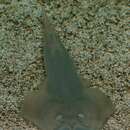en
names in breadcrumbs


Rhinobatos typus és un peix de la família dels rinobàtids i de l'ordre dels rajiformes.[2][3]
Pot arribar als 270 cm de llargària total.[4]
És ovovivípar.[5]
Es troba des de les costes de Tailàndia fins a Nova Guinea, Salomó i Austràlia.[4][6]
Rhinobatos typus és un peix de la família dels rinobàtids i de l'ordre dels rajiformes.
The common shovelnose ray, giant shovelnose ray or giant guitarfish[1] (Glaucostegus typus) is a species of fish in the Rhinobatidae family found in the central Indo-Pacific, ranging from India to the East China Sea, Solomon Islands and northern Australia.[1][3][4] It is found in shallow coastal areas to a depth of at least 100 m (330 ft), including mangrove, estuaries and reportedly also in freshwaters.[1][3][4] It reaches up to 2.7 m (8.9 ft) in length, and is greyish-brown to yellowish-brown above with a paler snout.[4]
This species has been tested for colour vision using choice experiments that control for brightness. It was the first rigorous behavioural evidence for colour vision in any elasmobranch.[5]
{{cite journal}}: CS1 maint: multiple names: authors list (link) The common shovelnose ray, giant shovelnose ray or giant guitarfish (Glaucostegus typus) is a species of fish in the Rhinobatidae family found in the central Indo-Pacific, ranging from India to the East China Sea, Solomon Islands and northern Australia. It is found in shallow coastal areas to a depth of at least 100 m (330 ft), including mangrove, estuaries and reportedly also in freshwaters. It reaches up to 2.7 m (8.9 ft) in length, and is greyish-brown to yellowish-brown above with a paler snout.
This species has been tested for colour vision using choice experiments that control for brightness. It was the first rigorous behavioural evidence for colour vision in any elasmobranch.
Glaucostegus typus es una especie de pez de la familia Rhinobatidae.
Pueden llegar alcanzar los 270 cm de longitud total.[2]
Es ovíparo.
Se encuentra desde las costas de Tailandia hasta Nueva Guinea, las Islas Salomón y Australia.
Glaucostegus typus es una especie de pez de la familia Rhinobatidae.
Glaucostegus typus Glaucostegus generoko animalia da. Arrainen barruko Rhinobatidae familian sailkatzen da.
Glaucostegus typus Glaucostegus generoko animalia da. Arrainen barruko Rhinobatidae familian sailkatzen da.
Glaucostegus typus is een vissensoort uit de familie van de vioolroggen (Rhinobatidae).[1] De wetenschappelijke naam van de soort is voor het eerst geldig gepubliceerd in 1830 door Anonymous [Bennett].
De rog heeft een driehoekige snuit, twee grote rugvinnen en stekels en tanden op de rug. Vanwege de vorm wordt deze rog gitaarrog genoemd. Ze wordt meer dan 2,7 m lang.
Het verspreidingsgebied is het oosten van de Indische Oceaan en het westen van de Grote Oceaan, tussen het Indische subcontinent en Australië: Thailand, Nieuw-Guinea, de Solomonseilanden. Ze worden regelmatig gevangen in netten van vissers.
Jonge vissen leven in ondiep water aan de kust in koraalriffen en mangrovemoerassen. Volwassen dieren leven in open, dieper zeewater tot op ongeveer 100 m. Ze voeden zich met schaaldieren (krabben en garnalen). De soort kan ook in zoetwater leven.
Glaucostegus typus is een vissensoort uit de familie van de vioolroggen (Rhinobatidae). De wetenschappelijke naam van de soort is voor het eerst geldig gepubliceerd in 1830 door Anonymous [Bennett].
De rog heeft een driehoekige snuit, twee grote rugvinnen en stekels en tanden op de rug. Vanwege de vorm wordt deze rog gitaarrog genoemd. Ze wordt meer dan 2,7 m lang.
Het verspreidingsgebied is het oosten van de Indische Oceaan en het westen van de Grote Oceaan, tussen het Indische subcontinent en Australië: Thailand, Nieuw-Guinea, de Solomonseilanden. Ze worden regelmatig gevangen in netten van vissers.
Jonge vissen leven in ondiep water aan de kust in koraalriffen en mangrovemoerassen. Volwassen dieren leven in open, dieper zeewater tot op ongeveer 100 m. Ze voeden zich met schaaldieren (krabben en garnalen). De soort kan ook in zoetwater leven.
Rhinobatos typus é uma espécie de peixe da família Rhinobatidae.
Pode ser encontrada nos seguintes países: Austrália, Bangladesh, Índia, Indonésia, Malásia, Singapura, Sri Lanka e Vietname.[1]
Os seus habitats naturais são: mar aberto, mar costeiro e águas estuarinas.[1]
Rhinobatos typus é uma espécie de peixe da família Rhinobatidae.
Pode ser encontrada nos seguintes países: Austrália, Bangladesh, Índia, Indonésia, Malásia, Singapura, Sri Lanka e Vietname.
Os seus habitats naturais são: mar aberto, mar costeiro e águas estuarinas.
Glaucostegus typus là một loài cá thuộc họ Rhinobatidae. Chúng được tìm thấy ở Úc, Bangladesh, Ấn Độ, Indonesia, Malaysia, Singapore, Sri Lanka, and Việt Nam. Các môi trường sống tự nhiên của chúng là open seas, biển nông, and estuarine waters.
Glaucostegus typus là một loài cá thuộc họ Rhinobatidae. Chúng được tìm thấy ở Úc, Bangladesh, Ấn Độ, Indonesia, Malaysia, Singapore, Sri Lanka, and Việt Nam. Các môi trường sống tự nhiên của chúng là open seas, biển nông, and estuarine waters.